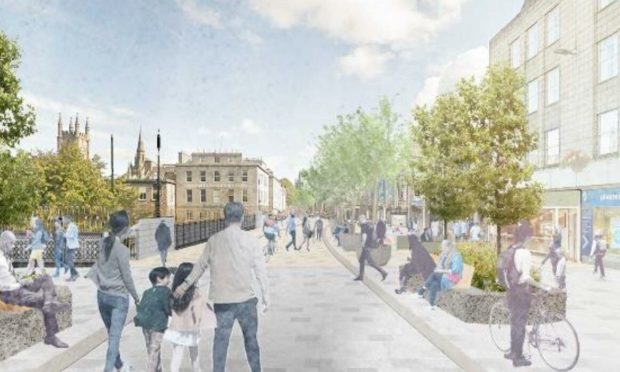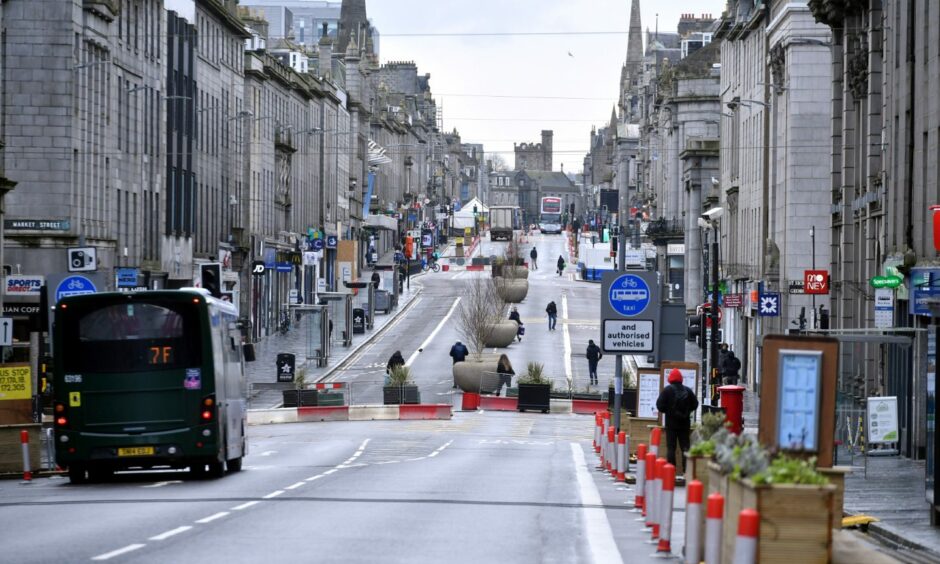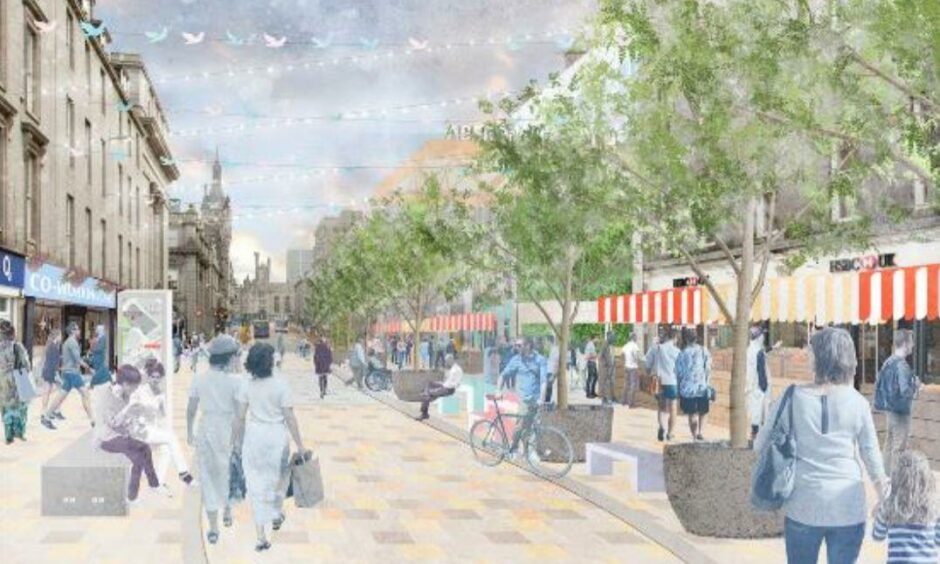Plans to permanently ban traffic from the central section of Union Street could be progressed next week.
Pedestrianising the stretch of Aberdeen’s main thoroughfare between Market Street and Bridge Street has long been an ambition of city leaders.
And top officials are seeking permission to expedite detailed planning of the permanent change to the area, tying it to the success of multi-million-pound regeneration projects.
Currently, around a fifth of the Granite Mile is already blocked off to all traffic, including buses, as part of the council’s £1.76 million physical distancing project, Spaces For People.
If voted through at next week’s meeting of city growth committee, the upheaval – initially brought in to allow pavement widening and safe space for cyclists – might soon become permanent.
Costs of the huge city-altering project are, as yet, unknown – however the partial pedestrianisation of Broad Street cost £3.2 million alone back in 2017.
Councillors could sign off on official work to draw up detailed designs and an estimate of how long it would take to introduce at a meeting next week.
It is expected to made a top priority at the Town House, in order to offer better links to the soon-to-be-rejuvenated Union Terrace Gardens (UTG) and new Aberdeen Market on the former British Home Stores site.
Close to 7,700 people took part in a recent public consultation on how to prioritise regeneration work in Aberdeen.
Nearly two in five respondents prioritised Union Street as the top priority, with 28% backing the idea of a pedestrianised central section.
Other highly-ranked concerns included calls for better upkeep of the Granite Mile and its buildings and a desire for more flowers and green spaces.
Resources director, Steve Whyte, told councillors: “With regard to streetscape design development, it is recommended that Union Street Central be prioritised to move to detailed design and stakeholder engagement to support the development of not only the Market site, but to ensure connectivity to Union Terrace Gardens.
“The remaining streetscape visioning works require to be developed further and a full programme of stakeholder engagement, detailed design and delivery is to be developed in tandem with a detailed traffic management plan.
“This will also require taking cognisance of existing committed work relating to a city centre Low Emission Zone (LEZ) and the Bus Partnership Fund.”
The work ties in with a much wider refresh of the city centre masterplan, backed by £150m, which is expected to bring significant change – including a new football stadium – to Aberdeen beach.
What changes are being considered?
The Bridge Street and UTG end of the zone could be sculpted out of planters, leading to a “wavy” route down Union Street.
Along its length, there are plans for a 10ft widening of pavements to allow pedestrians to more easily pass by cafes and shops plying their trade outside.
There are also proposals for a green pocket park, allowing stepped seating on the edge of St Nicholas Kirkyard.
Council planners identify the potential Aberdeen Market as a highlight of a journey along Union Street, with potted trees continuing the wavy lane down the Granite Mile.
It is hoped market stalls will spill out of the planned development, sited at BHS, with added seating creating “places to linger” after hours.
This would merge into a plaza running from the new market in Market Street to the St Nicholas Centre.
Further east, Union Street would continue to be tree-lined to “add grandeur and mitigate against the worst of the weather” – with plans to open up the Castlegate to better link it with the rest of the city centre.
And the troublesome, trip-hazard surface would finally be replaced or repaired – something promised for years in the face of growing complaints about the shaky, cracked slabs.
Ideas for the area include an e-bike charging station, with hopes of making more of the historic square for active travel – linking Aberdeen’s main street and the bus and train stations to the beach – or a large water feature at the Plainstanes in Castle Street.
At the top end of Union Street, towards the Holburn junction, there are plans to build plazas in among the trees lining the road, in an effort to make more of buildings like the Music Hall.
Roads planners are also pondering bus filter lanes, bike lanes running up the middle of the street or yet more greenery to separate the lanes of traffic.
Full consultation on long-lasting change in contrast to temporary Covid road changes
Unlike when many streets around the city centre were first closed as part of the coronavirus response, residents, traders and other road users, including bus firms, will be consulted more thoroughly if the plans are approved.
The Market Street to Bridge Street strip has the city’s seven busiest bus stops, and both First Bus and Stagecoach hit out at the “disheartening” talks they had with the council as the road was hastily closed.
At this time, the possibility of partial pedestrianisation, maintaining public transport access, has not been ruled out.
Disabled parking, placement of taxi ranks, loading space and access for businesses and charging for electric vehicles will also be taken into consideration.


